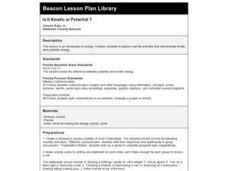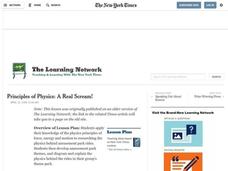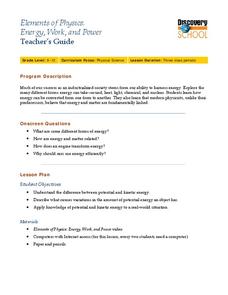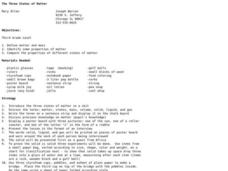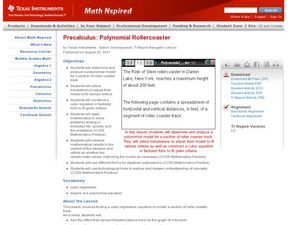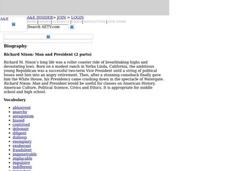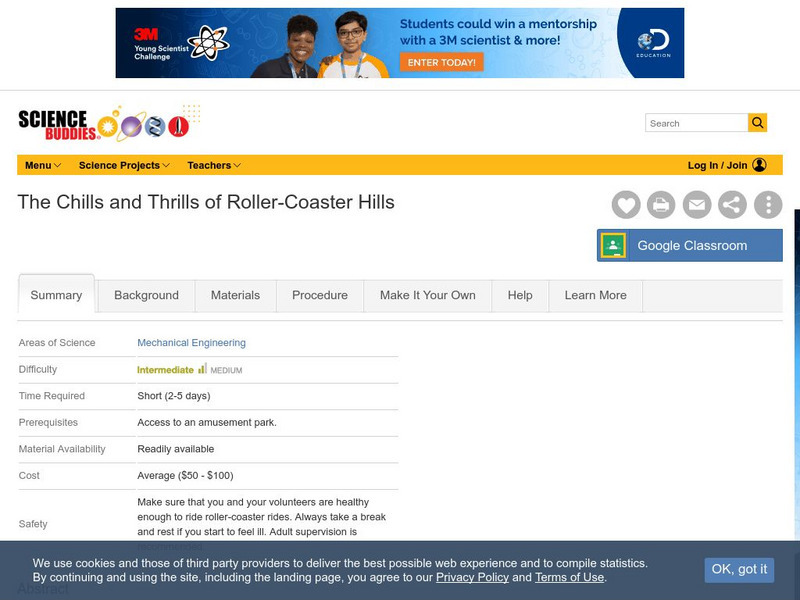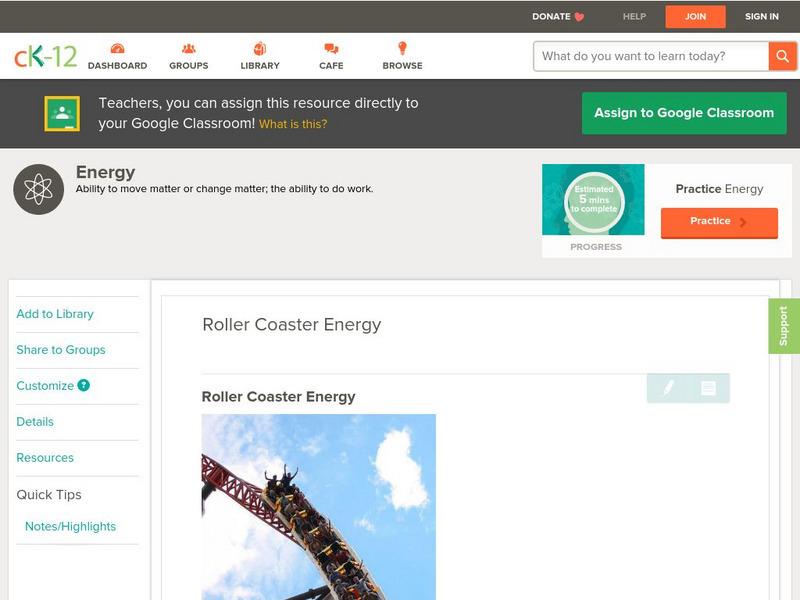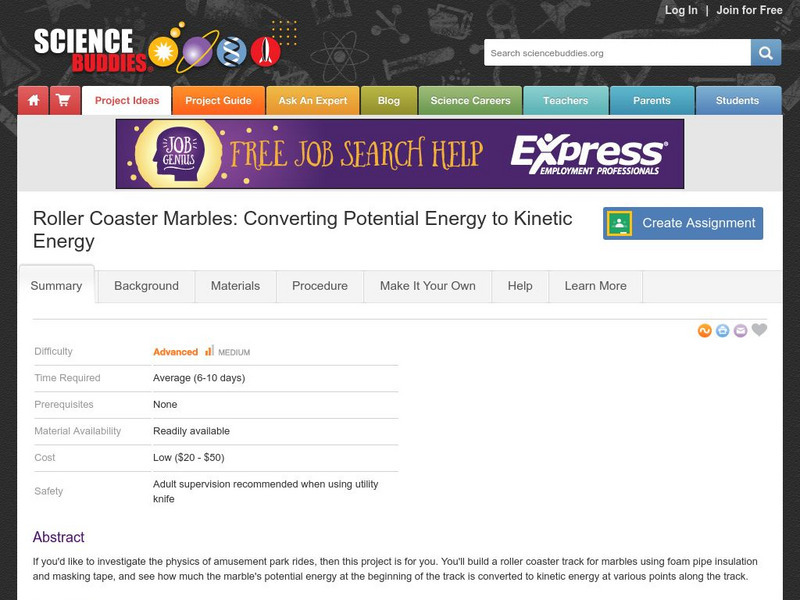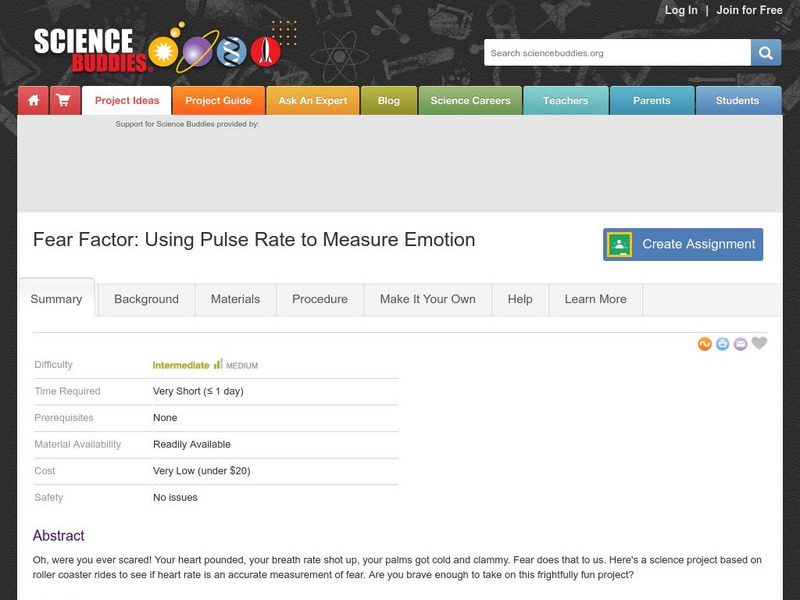Curated OER
Is It Kinetic or Potential ?
Seventh graders explore real life activities that demonstrate kinetic and potential energy. They, in groups, classify the activity card statements as kinetic or potential. They should also include where the potential and kinetic energy...
Curated OER
Principles of Physics: A Real Scream!
Students apply their knowledge of the physics principles of force, energy and motion to researching the physics behind amusement park rides.
Curated OER
Energy, Work and Power
Students examine the differences between potential and kinetic energy. In this physics lesson students view a video and apply what they learn about energy to apply it to real world situations.
Curated OER
Measure for Measure: Weight and Energy
Students study the friction of a particular sport. In this weight and energy lesson students choose a sport and us the Internet to research it then present their findings to the class.
Curated OER
Kinetic Vs. Potential Energy
Eighth graders listen to a teacher lecture and observe a demonstration of both potential energy and stored energy. After discussing the characteristics and examples of different types of energy, 8th graders make predictions and then...
Curated OER
The Three States of Matter
Third graders identify properties of solids, liquids, and gasses. In this states of matter lesson, the teacher demonstrates the properties of each state of matter, then students go on a scavenger hunt for items to represent each state...
Curated OER
Kepler's Second Law
Students explore orbital velocities and how they vary along each orbit, according to Kepler's Second Law.
Curated OER
Engineering Activity
In this engineering worksheet, students research engineering and fill in blanks to complete sentences. A reference web site is given.
Teach Engineering
Pushing it Off a Cliff
Focus on the conservation of energy, specifically looking at gravitational potential energy and kinetic energy, with a lecture that involves having friends throw light objects at each other to determine which has more kinetic energy and...
K12 Reader
Subject Pronouns
What or who can subject pronouns stand for? Ask your learners to determine the correct subject pronoun for 25 sentences. Learners are given the subjects and choose the pronouns from a chart of options.
Curated OER
Reflections
Learners explore reflection of polygons on a coordinate plane. They examine the relationships that exist between corresponding points and sides.
Curated OER
Polynomial Rollercoaster
Learners relate polynomials to a rollercoaster track as they translate a graph around on a coordinate plane. They differentiate between different forms of algebraic expressions.
Curated OER
Measuring Body Parts
Students engage in a lesson to measure body parts. They use the measuring tape to record the data of body measurements. Students must choose the appropriate unit of measurement and compare the data for the different parts of the human body.
Curated OER
Homework Master: er and est
In this spelling worksheet, students read ten sentences and fill in the blanks with words with the "er" and "est" suffixes. Students than answer each riddle.
Curated OER
Everyone can explore architecture
Students draw like an architect. In this interdisciplinary lesson, students research and draw several examples of different forms of architecture through societies, cultures and times, then present them to the class.
Curated OER
Richard Nixon: Man and President (2 parts)
Students watch the video "Richard Nixon: Man and President, complete vocabulary work and discuss the video using the question provided.
Science Buddies
Science Buddies: Roller Coaster Marbles: How Much Height to Loop the Loop?
This is a really fun project even if you don't like going on roller coasters yourself. You'll build a roller coaster track for marbles using foam pipe insulation and masking tape, and see how much of an initial drop is required to get...
Science Buddies
Science Buddies: The Chills and Thrills of Roller Coaster Hills
Lots of people enjoy roller coasters, but not many understand why they feel the strange excitement they do when riding them. In this science fair project, you will build and use an accelerometer to figure out and measure gravity-induced...
Science Buddies
Science Buddies: Paper Roller Coasters: Kinetic and Potential Energy
In this lesson, your students will learn about kinetic and potential energy as they build their own roller coasters from simple classroom materials.
CK-12 Foundation
Ck 12: Roller Coaster Energy
[Free Registration/Login may be required to access all resource tools.] Some prefer the front seat, some prefer the back seat and others prefer to not even board a roller coaster at the amusement park. What is the science that makes...
Science Buddies
Science Buddies: Converting Potential Energy to Kinetic Energy
If you'd like to investigate the physics of amusement park rides, then this project is for you. You'll build a roller coaster track for marbles using foam pipe insulation and masking tape, and see how much the marble's potential energy...
Science Buddies
Science Buddies: Fear Factor: Using Pulse Rate to Measure Emotion
Do you remember a situation when you heart pounded, your breath rate shot up, and your palms got cold and clammy? Fear does that to us. Here's a science project based on roller coaster rides to see if heart rate is an accurate...
Other
Hstry: Roller Coaster Design Brief Template
Interactive site by STEM teacher Mariana Garcia-Serrato in a lesson on physics in which students design, budget for and analyze their own roller coasters.
Museum of Science
Museum of Science and Industry, Chicago: Activities: Build a Roller Coaster
Build the roller coaster, then keep making adjustments to see how it affects the potential and kinetic energy of the marble along its tracks.


